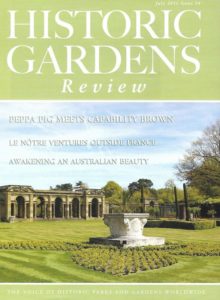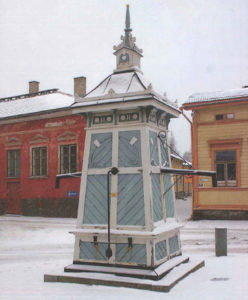"A big, cream and white wooden structure shaped like a giant flower pedestal but with a human-size door was utterly intriguing."

The Historic Gardens Review published by the Historic Gardens Foundation is available by subscription from the Foundation. Copies are also accessible in the Royal Horticultural Society’s Lindley Library, London.
A decorative arts study tour to Helsinki in May 2016, brought an unexpected opportunity to visit Helsinki’s Botanic garden.
A major refurbishment was evidently underway but there was still much to admire, not least in the range of glasshouses chronicling the evolution of plant life.
The prospect of orange trees naturally drew me in but the real delight, and for several months a puzzle, lay outside. A big, cream and white wooden structure shaped like a giant flower pedestal but with a human-size door was utterly intriguing.
Unfortunately the photograph of the mysterious pedestal was too blurry to be included in the article subsequently commissioned by the editor of Historic Gardens Foundation’s magazine.
But it was through the HGF‘s encouragement to contact an expert on Finnish gardens, the Swiss scholar, Dr Eeva Ruoff, that the mystery was eventually solved.
Dr Ruoff immediately identified the wooden structure as one of Helsinki’s few surviving original well huts.
Once a common feature on the streets of Helsinki and elsewhere, pavement laying and road extensions decimated their numbers. That in the Helsinki Botanic Garden survives because it was relocated and re-purposed as a garden feature.

The delightful well-hut is located in Rauma, on the west coast of Finland. Image courtesy of Dr Eeva Ruoff.
Others, like this one at Rauma, on Finland’s west coast and north of the old capital, Turku, survive in situ. Rausa’s old town with its wooden houses is a UNESCO World Heritage Site.
